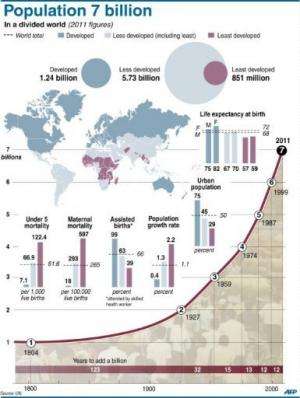World population to hit 10 bln, but 15 bln possible: UN

The world's population of seven billion is set to rise to at least 10 billion by 2100, but could top 15 billion if birth rates are just slightly higher than expected, the United Nations said on Wednesday.
In a report ahead of ceremonies on October 31 to mark the seven billionth human alive today, the UN Population Fund (UNFPA) warned demographic pressure posed mighty challenges for easing poverty and conserving the environment.
"This is a challenge and a call to action. The issue of population is a critical one for all humanity and for planet Earth," Babatunde Osotimehin, the UNFPA's executive director, said at the launch of the report in London.
But he said that the world should focus on how to make the world a better place to live instead of worrying only about numbers.
"This is not a matter of space, it's a matter of equity, opportunity and social justice," he told journalists.
He called for a focus on the rights of women and young people to help keep the global population in check.
"From the Arab Spring to the sit-ins at Wall Street, people are demanding change and young people in particular," he said. "Educating and empowering girls and women allows them to have fewer children than their mothers and grandmothers did."
New estimates see a global human tally of 9.3 billion at 2050, an increase over earlier figures, and more than 10 billion by the end of the century, the UNFPA report said.

But, it added, "with only a small variation in fertility, particularly in the most populous countries, the total could be higher: 10.6 billion people could be living on Earth by 2050 and more than 15 billion in 2100."
The 126-page document, "The State of the World Population 2011", highlights a surge that began with the post-World War II baby boom -- a numbers "bulge" that shows up in following generations as they in turn grow up and have children.
In contrast, prosperity, better education and access to contraception have slashed the global fertility rate to the point that some rich countries have to address a looming population fall.
Over the past six decades, fertility has declined from a statistical average of 6.0 children per women to about 2.5 today, varying from 1.7 in the most advanced economies to 4.2 in the least developed nations.
Even so, 80 million people each year are added to the world's population. People under 25 comprise 43 percent of the total.

The report highlighted these challenges:
- HELPING YOUTH: Having large numbers of young adults offers many poor countries the hope of rising from poverty.
But, warns the UNFPA, "this opportunity of a 'demographic dividend' is a fleeting moment that must be claimed quickly or lost." Finding jobs for this swelling sea of youngsters is essential.
It notably quotes from a report by the UN's International Labour Organisation (ILO) which suggests the 23.4-percent youth unemployment in the Arab world was a major contributor to the uprisings there.
- GREEN WORRIES: The report cites environmental problems that are already pressing and set to intensify as demand grows for food, energy and homes.
Referring to a yardstick of sustainability used by the environmental thinktank Global Footprint Network, the report said it now takes the Earth 18 months to regenerate the natural resources that we use in a year.
"Climate change and rapid population growth are among the many factors contributing to the current drought and famine in the Horn of Africa, which has affected more than 12 million people," it says.
Future concerns focus especially on water stress. "Analysis suggests that the world will face a 40-percent global shortfall (in water) between forecast demand and available supply by 2030," says the report, citing Egypt -- hugely dependent on the Nile -- as a particular example.
- CITY FUTURES: The balance between rural and urban populations "has tipped irreversibly" towards cities in today's world of seven billion. The biggest urban agglomeration, as defined by the UNFPA, is Tokyo, with 36.7 million people, followed by Delhi, with 22 million, Sao Paulo, 20 million and Mumbai, with 20 million.
As the world's population expands, better urban planning, with closer involvement of residents, will be essential. Adequate housing, sanitation and green spaces should be incorporated in the shaping of cities rather than ad-hoc growth that leads to shanty towns.
- IMMIGRATION: In rich countries where populations are becoming top-heavy with the elderly, the task will be to meet growing demands for labour. Immigration, one of the options, needs to be orderly and managed so that migrants are better integrated and protected.
- FAMILY PLANNING: Dozens of countries are lagging in achieving the UN's Millennium Development Goal of providing universal access to reproductive health, said the report.
(c) 2011 AFP

















